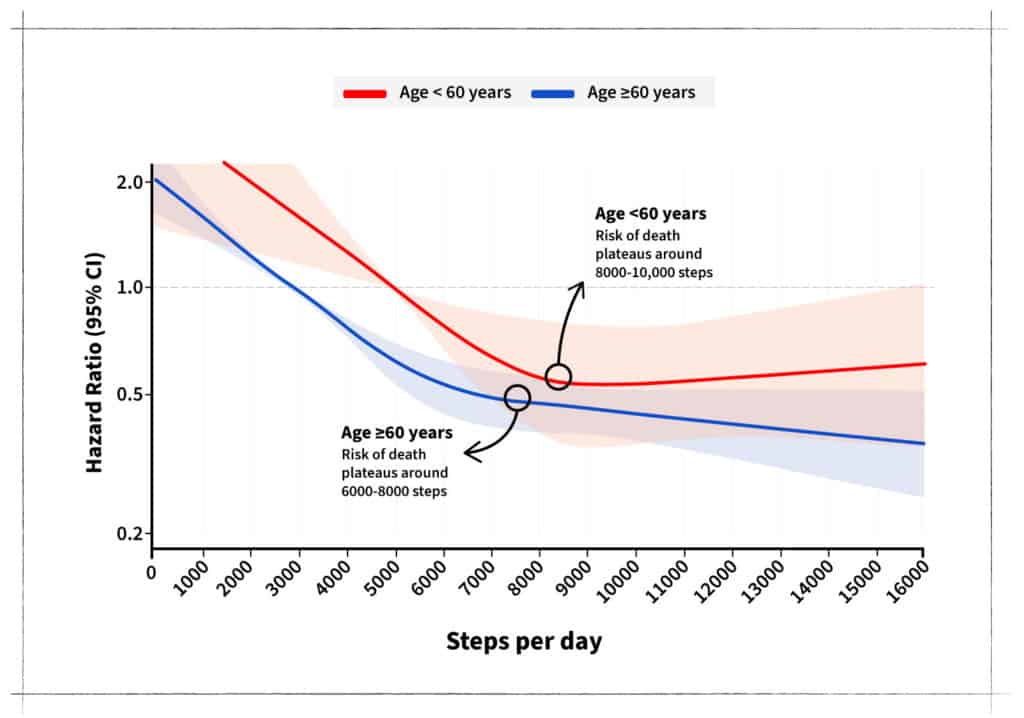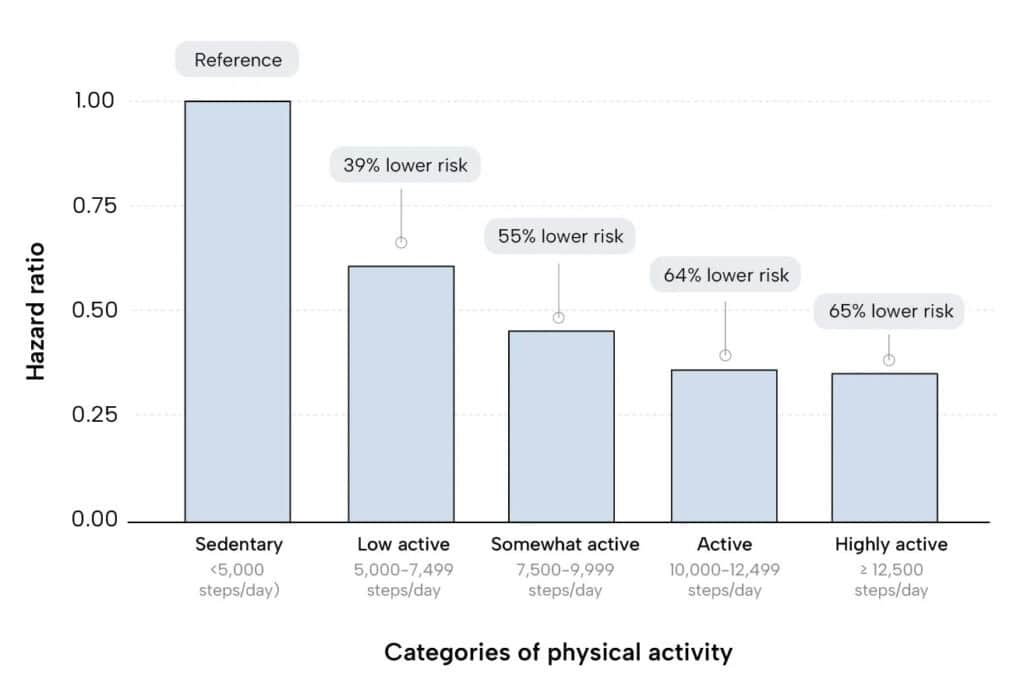This post is taken from the Vitamin. Every Thursday, I drop some knowledge bombs on your face to help you reach your goals faster while avoiding all the bullshit.
The year is 1965. And a Japanese company, Yamasa Tokei, has just launched the world’s first commercial pedometer––Manpo-Kei, which translates to “10,000 steps meter” in English. And, well, the rest, as they say, is history.
But despite how firmly the 10,000 step rule is entrenched in the fitness zeitgeist, the 10,000 steps figure wasn’t based on any science; it was just a marketing campaign used to sell the company’s pedometer, and how many steps we should be taking isn’t that clear-cut.
For example, a 2019 study looked at the association between the number of steps and all-cause mortality in ~16,000 older women (mean age 72 years). Indeed, the higher the step count, the lower the mortality rate at the 4-year follow-up. But the risk of mortality significantly declined at little as ~4,000 steps/d and levelled off at about 7,500 steps/d. 1
In line with these findings, Paluch et al. (2021) reported middle-aged adults (41-65 years) taking at least 7,000 steps per day, compared with those taking fewer than 7,000 steps/d, led to a 50-70% lower mortality risk while taking more than 10,000 steps/d wasn’t associated with a further reduction in mortality risk. 2
Another paper looked at the association of step count and all-cause mortality in a sample of US adults aged at least 40 years and found a greater step count was associated with lower all-cause mortality, with a steep decline in mortality going from 2000 to 8000 steps/d and levelling off around 12,000 steps/d. 3
In contrast, a recent meta-analysis found a dose-response relationship between total daily steps and the risk of death. In particular, as steps increased from 2,700 up to 17,000 steps per day, the risk of mortality also decreased. 4
Well, a new study set out to try and resolve these conflicting findings by reviewing the current research to see how the number of steps per day affected the risk of death. The primary objective was to assess the dose-response association between daily steps and all-cause mortality.
What did the researchers do?
The researchers used two strategies to identify studies for this meta-analysis. The first was a typical systematic review of daily step count and associations with all-cause mortality. The researchers identified five studies, but this amount was deemed too low for the meta-analysis. To solve this, the researchers also included ongoing and unpublished studies measuring steps and mortality (as long as they met the inclusion criteria).
Wait, hold up, why include unpublished studies? Imagine you’re a researcher. You spend months conducting a study, and in the end, you don’t find a positive effect. As a result, you may decide not to submit the study for publication as it’s likely to be rejected. That, and negative findings aren’t as likely to do much for your career. This is called “publication bias”––where only positive findings are published, regardless of the quality of the study. The problem with this is that it can bias the weight of the research. For instance, imagine five studies are conducted to see if a new supplement increases fat loss. Two studies find a positive effect, while three studies find a negative effect. When we look at all five studies, we can agree the supplement likely isn’t effective for fat loss. However, if the negative findings are never published, we may wrongly assume the supplement has an effect, even if it doesn’t.
For a study to be eligible, it had to be a longitudinal design (i.e., long term), participants had to be aged 18 or over, and it needed to have reported an association between daily step count and mortality.
The researchers also conducted a series of sensitivity analyses:
- They investigated the potential for reverse causation by excluding participants who died within the first two years of follow-up. In other words, was the risk of death due to a low step count or other factors unrelated to step count––like diseases or other health conditions.
- The average follow-up length: comparing studies with less than six years of follow-up and six years or longer of follow-up.
- They did an analysis using a “leave-one-out” approach, where each study was excluded one at a time to ensure the results were not due to an outlier study.
- They also used a “leave one-device-out” approach, excluding studies that used a specific step-monitoring device, to determine if the dose-response estimates of steps were affected by any single device.
15 studies were included in the final meta-analysis. Four studies were in Europe, one in Japan, one in Australia, eight in the USA, and one included data from 40 countries. Seven studies were published, and eight were unpublished.
The total sample included 47,471 participants (68% or 32,226 of which were female), with a median study follow-up of 7 years, 297,837 person-years, and a total of 3013 deaths were reported. The quality of the studies was high, ranging from 7 to 9 out of a possible 9 points (based on the Newcastle Ottawa quality assessment scale).
What did the researchers find?
Compared with adults in the lowest steps per day quartile (3553 steps/day), adults in the highest steps per day quartile (10,901 steps/day) had a 40% to 53% lower mortality risk.
But as the image below illustrates, there was a progressive decrease in mortality risk plateauing around 6,000-8,000 steps for adults aged 60 years and over and 8,000-10,000 steps per day for adults younger than 60 years.

As for the sensitivity analyses:
- When excluding deaths within the first two years of follow-up, the association between steps per day and mortality was attenuated but remained significant.
- The association between step counts and mortality was stronger in the six studies with fewer than six years of follow-up (hazard ratio 0·32 [95% CI 0·25–0·41]) than among the nine studies with six years of follow-up or more (0·57 [0·49–0·66]) when comparing the lowest and highest quartile.
- There was a significantly lower hazard ratio for published (0·54 [0·42–0·68]) than unpublished studies (0·73 [0·63–0·85]) when comparing the first and second quartile.
- There were no appreciable differences in the association between steps per day and mortality when excluding any one study or step-counting device.
Heterogeneity (i.e. the difference in results between studies) was low to moderate. Finally, there was inconsistent evidence that step intensity (how fast someone walked) was associated with mortality beyond the total number of steps.
Practical applications
In the present study, researchers found increasing steps can be beneficial for reducing the risk of mortality. However, they also found the risk of death plateaus around 6,000-8,000 steps for adults aged 60 years and over and 8,000-10,000 steps per day for adults younger than 60 years.
These findings aren’t that surprising, considering everything has a point of diminishing returns, and more doesn’t always equal better. If you’re completely sedentary, increasing your physical activity (including daily steps) may reduce your risk of death and disease, but if you’re already fairly active, doing more physical activity isn’t likely to confer as significant a benefit.
Now, to be clear, in case what I’m saying is misconstrued, I’m not encouraging you to be less active.
You should try to increase daily movement and be as physically active as possible. A large amount of research shows that higher levels of weekly physical activity is an important factor in weight maintenance. For example, a recent paper noted that increased physical activity “was the most consistent positive correlate of weight loss maintenance.” 5 And walking is an easy way to ramp up daily and weekly activity.
Additionally, prolonged sitting can impair the metabolic benefits of exercise, like fat oxidation, reduced plasma triglycerides, and increased insulin sensitivity. 6 7 8 And there’s some evidence to suggest athletes who are more sedentary tend to have higher levels of body fat, independent of time spent training. 9
So yes, you should definitely try to reduce the amount of time you’re seated and/or sedentary. Looking at these studies together, you can see that moving more has health benefits. I know, what a shocker, right? And while more movement (or steps) can reduce the risk of mortality and disease, the health benefits are seen at amounts below the popularised 10,000 steps. So instead of stressing out about hitting an arbitrary number, be more focused on adding movement into your day in a way that makes sense for you.
Update
A recent umbrella review by Rodríguez-Gutiérrez and colleagues 10 found an inverse relationship between daily steps and the risk of death. In other words, more steps were linked to a lower mortality risk. However, this relationship was nonlinear, meaning the initial increases in steps led to significant reductions in mortality risk, but these benefits tapered off as the step count continued to increase.

Their analysis also found the optimal number of steps per day to reduce the risk of death was between 7,000 and 9,000, and the minimum number of steps needed to start seeing a protective effect against the risk of death was 3,143 steps per day. Similar to previous findings, each additional 1,000 steps were associated with a 9% reduction in the risk of death from any cause.
In a separate analysis, the researchers explored how different levels of daily steps impact the risk of death compared to a sedentary lifestyle (<5000 steps/day).
- For those with low activity levels (5000-7499 steps/day), the risk of death was reduced by 39% compared to those walking fewer than 5000 steps/day.
- The somewhat active group (7500-9999 steps/day) saw a 55% reduction in mortality risk compared to those walking fewer than 5000 steps/day.
- Those in the active category (10,000-12,500 steps/day) saw a 64% lower risk compared to those walking fewer than 5000 steps/day.
- The highly active group (≥12,500 steps/day) benefitted from a 65% reduction compared to those walking fewer than 5000 steps/day.

As I mentioned in the main article, people fall into the trap of associating more with better. In the case of step counts, this is generally true. For example, in this study, going from ~3000 steps/day to ~14,000 steps/day was associated with a 70% reduction in the risk of all-cause mortality. However, it’s very unlikely that someone who’s currently hitting ~3000 steps/day is suddenly going to start walking 14,000 steps/day consistently.
Instead, it’s more common to see people gradually increase their steps, jumping from one step ‘bucket’ to the next (e.g. 3000-5000 steps/day to 5000-7000 steps/day). Therefore, it’s worth contextualising what an incremental increase in step count translates to in terms of risk reduction.
To set the scene, the reference value for the total sample was 3,143 steps per day, meaning ~3,000 steps per day were used as a baseline value against which the other step counts were compared. A hazard ratio of 1.0 is assigned to the reference value (a hazard ratio of 1.0 means no difference in risk compared to the baseline, while a hazard ratio greater than 1 indicates increased risk and less than 1 indicates reduced risk).
Here’s a table from the study showing a breakdown of different step counts and the associated hazard ratio (along with the 95% confidence interval in brackets).

Based on this study’s findings, someone walking 2,000 steps per day has a 27% increased risk of all-cause mortality compared to someone walking ~3000 steps. Going from ~3000 steps per day to 6,000 is an almost 50% reduction in the risk of death. Going from 6000 to 8000 steps is a ~26% reduction in the risk of death, and going from 8000 to 10,000 steps is a ~13% reduction in risk.
You can run dozens of scenarios and combinations, but the point is that once you’re doing about 6,000-10,000 steps, you’re getting most of the health benefits. Doing more steps will confer additional benefits, but you’re looking at marginal gains for a much larger time commitment. That being said, and assuming the relationship between step count and risk of mortality is causal, aiming for 8,000-10,000 steps is probably the ‘safer than sorry’ approach. (Note: You can read a detailed review of this new study here.)
Thanks for reading. If you enjoyed this, you’d love the Vitamin

95% of my new content is only being sent to my email list. One email every Thursday, filled with actionable, evidence-based fitness advice to help you with your goals. If you enjoyed this, you’ll love my emails. You can learn more and subscribe for free here.